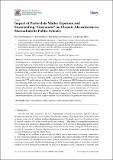| dc.contributor.author | MacNaughton, Piers | en_US |
| dc.contributor.author | Eitland, Erika | en_US |
| dc.contributor.author | Kloog, Itai | en_US |
| dc.contributor.author | Schwartz, Joel | en_US |
| dc.contributor.author | Allen, Joseph | en_US |
| dc.date.accessioned | 2017-04-06T03:22:36Z | |
| dc.date.issued | 2017 | en_US |
| dc.identifier.citation | MacNaughton, Piers, Erika Eitland, Itai Kloog, Joel Schwartz, and Joseph Allen. 2017. “Impact of Particulate Matter Exposure and Surrounding “Greenness” on Chronic Absenteeism in Massachusetts Public Schools.” International Journal of Environmental Research and Public Health 14 (2): 207. doi:10.3390/ijerph14020207. http://dx.doi.org/10.3390/ijerph14020207. | en |
| dc.identifier.issn | | en |
| dc.identifier.uri | http://nrs.harvard.edu/urn-3:HUL.InstRepos:32072246 | |
| dc.description.abstract | Chronic absenteeism is associated with poorer academic performance and higher attrition in kindergarten to 12th grade (K-12) schools. In prior research, students who were chronically absent generally had fewer employment opportunities and worse health after graduation. We examined the impact that environmental factors surrounding schools have on chronic absenteeism. We estimated the greenness (Normalized Difference Vegetation Index (NDVI)) and fine particulate matter air pollution (PM2.5) within 250 m and 1000 m respectively of each public school in Massachusetts during the 2012–2013 academic year using satellite-based data. We modeled chronic absenteeism rates in the same year as a function of PM2.5 and NDVI, controlling for race and household income. Among the 1772 public schools in Massachusetts, a 0.15 increase in NDVI during the academic year was associated with a 2.6% (p value < 0.0001) reduction in chronic absenteeism rates, and a 1 μg/m3 increase in PM2.5 during the academic year was associated with a 1.58% (p value < 0.0001) increase in chronic absenteeism rates. Based on these percentage changes in chronic absenteeism, a 0.15 increase in NDVI and 1 μg/m3 increase in PM2.5 correspond to 25,837 fewer students and 15,852 more students chronically absent each year in Massachusetts respectively. These environmental impacts on absenteeism reinforce the need to protect green spaces and reduce air pollution around schools. | en |
| dc.language.iso | en_US | en |
| dc.publisher | MDPI | en |
| dc.relation.isversionof | doi:10.3390/ijerph14020207 | en |
| dc.relation.hasversion | http://www.ncbi.nlm.nih.gov/pmc/articles/PMC5334761/pdf/ | en |
| dash.license | LAA | en_US |
| dc.subject | PM | en |
| dc.subject | air pollution | en |
| dc.subject | NDVI | en |
| dc.subject | greenness | en |
| dc.subject | absenteeism | en |
| dc.subject | public schools | en |
| dc.title | Impact of Particulate Matter Exposure and Surrounding “Greenness” on Chronic Absenteeism in Massachusetts Public Schools | en |
| dc.type | Journal Article | en_US |
| dc.description.version | Version of Record | en |
| dc.relation.journal | International Journal of Environmental Research and Public Health | en |
| dash.depositing.author | MacNaughton, Piers | en_US |
| dc.date.available | 2017-04-06T03:22:36Z | |
| dc.identifier.doi | 10.3390/ijerph14020207 | * |
| dash.contributor.affiliated | Eitland, Erika | |
| dash.contributor.affiliated | MacNaughton, Piers | |
| dash.contributor.affiliated | Schwartz, Joel | |
| dash.contributor.affiliated | Allen, Joseph | |
| dc.identifier.orcid | 0000-0002-2557-150X | |


